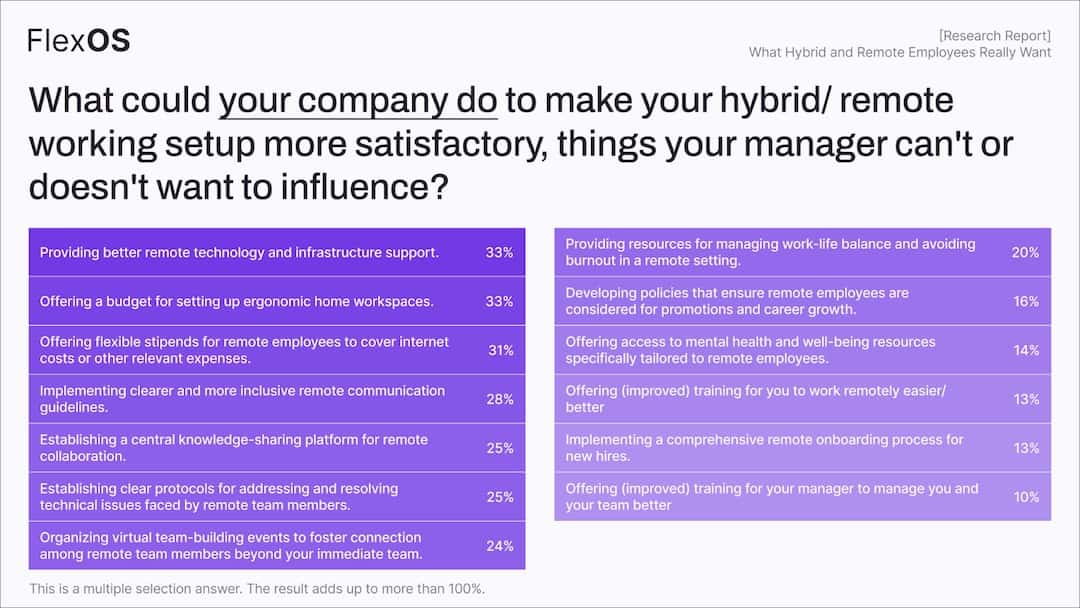Work from Anywhere is a new phenomenon adopted by some of the most progressive companies in the world.
So what is Work from Anywhere?
What should you consider when writing your Work from Anywhere policy?
And how do you actually write your Work from Anywhere policy? Are there any good examples out there?
In this article, I will dive into all of the above and make sure you’re ready to rock your Work from Anywhere policy.
Let’s go!
Elements of an effective work-from-anywhere policy
First, let’s level set; as we both know, a lot has happened in recent years.
Here’s the truth: the office is no longer the workplace.
Work is done in the office, but work is done in many places.
In the post-COVID world, the truth is that the office is no longer the workplace.
In a post-COVID workplace, people and their employers learned they can work from anywhere.
This led to companies creating new policies, including Work from Anywhere and other forms of hybrid remote work.
So what exactly is Work from Anywhere?
Work from Anywhere is best explained through a simple formula, in which the company headquarters (HQ) is combined with remote work (at home (WFH) or near home (WNH), for example, in a coworking space.)
In short: HQ + WFH + WNH = Work From Anywhere
I know that sounds great.
So, how do we make it work?
What should you consider in your Work from Anywhere policy?
To make sure your Work From Anywhere (WFA) succeeds, consider important elements like your company culture, employee preferences, and, yes, even the legal context.
I suggest spending some time thinking about:
1. Legal and Regulatory Compliance:
Understand applicable regulations, wage and hour laws, benefits, and tax implications for remote employees across different regions.
2. Company Culture and Equity:
Ensure inclusivity and fairness in your WFA policy, addressing potential employee disparities.
Define expectations for remote communication and collaboration to maintain a cohesive company culture.
3. Technology and Data Security:
Provide the necessary technology and tools: lacking the right tech is the #1 frustration remote team members have with the company. And one in two managers like yourself have better technology on their wishlist for the company to support them better.
Also, comply with data privacy laws to protect intellectual property and confidential information.

4. Employee Support
Encourage work-life balance for remote employees; working outside the office means work and life blend together, sometimes resulting in work-from-home loneliness.
Helping people keep a healthy balance is key.
5. Productivity
One way to keep things sane is by setting clear guidelines around productivity. Not to put unreasonable targets for people but to avoid toxic productivity.
Establish clear performance expectations so people know what’s expected of them regarding employee productivity.
6. International Considerations:
Be aware of immigration, visa requirements, and potential travel cost coverage for international remote work.
7. Financial Considerations:
Evaluate cost reimbursement for work-related expenses.
Our research shows that 33% of employees want a budget for setting up ergonomic home workspaces, and 31% want a flexible stipend to cover internet and other relevant expenses.

Considering these factors, you can create a robust and balanced WFA policy that’ll work for you in the long run.
How to create a Work from Anywhere policy
Creating a Work from Anywhere policy or hybrid work policy means crafting a work agreement that works for you and your team or company.
This happens when you take the following steps:
1. Understanding your organization's needs and culture
Assess your company goals, culture, and the type of work you do.
Identify your priorities, such as cost savings, productivity, and culture. If your company's priority is significant cost-cutting, the Work from Anywhere work model may not meet your goals, and fully remote or remote-first would be better.
But it might be the perfect fit if you want to balance wins for you and your team. This analysis lays the foundation to determine your leadership team and company's preferred approach to hybrid work.
2. Gather input from employees and managers.
It is crucial to get insights from your people on how many days they prefer in-office versus remote, collaboration requirements such as the right tools and systems, or any potential challenges they may have.
This participatory approach means you’ll more likely have buy-in on this important change. According to a 2023 Gartner study, three-quarters of digital workers want to participate in creating their hybrid work model.
Combine strategic decision-making with bottom-up insights to design the most appropriate model - the right blend. When you have a holistic picture of the company's needs and employee's perspectives, you can craft a hybrid work schedule that strikes the ideal balance between remote and in-office work.
This is how I approached designing our policy (2 days in the office, three days from anywhere.) I asked many questions, drafted a concept, and got more input.
This approach definitely helped in making it something people are willing to accept and, in our case, even enjoy.
3. Test the Work from Anywhere schedule
Before implementing a Work from Anywhere policy, it's worth testing it with a pilot phase.
This will enable you to receive feedback through surveys and interviews to understand what works effectively and what needs improvement.
It will also allow you to identify potential challenges, fine-tune the model, and improve it significantly.
Piloting the schedule would also increase employee buy-in and help you to solve any issues beforehand before rolling out the new schedule to all team members.
4. Document the structure of the model and provide clear guidelines
Once the pilot has refined the hybrid model, it's crucial to document it clearly for your team or company. There’s nothing people dislike more than not knowing. Clarity is key, as I’ve learned the hard way.
Outline a clear Work from Anywhere or hybrid work policy around core hours, meetings, expectations for in-office days, collaboration norms, and other guidelines. Ensure that everyone is aware of the responsibilities of managers and employees.
Find our hybrid working policy template here.
4. Implement and refine the Work from Anywhere policy
With insights from the pilot, it's time to start implementing the work from anywhere schedule in your team or company.
Continue to collect feedback, monitor productivity, and address any pain points. Refine policies and team schedules to optimize how hybrid work benefits your business and people.
5. Evaluate the effectiveness, monitor success, and adopt
Evaluate the overall effectiveness of your new Work from Anywhere policy schedules at least quarterly.
Examine metrics like productivity, engagement, and turnover. Keep adapting to enhance how hybrid work functions across your organization.
Make this a priority: what gets measured gets done!
Benefits of Work from Anywhere
Across studies and remote work statistics, I spotted three key benefits to Work from Anywhere:
- Studies show that working from home makes people feel empowered, in control, and focused. This allows them to be more productive.
- Granting employees flexibility gives companies an edge over others. This is important to attract and retain talent, especially in our highly competitive recruitment market.
- Offering remote work can save over 90% as companies need less office space and the operating costs that come with it.
No wonder companies are looking into Work from Anywhere as a great alternative to a full-time office.
Examples of how Work from Anywhere works practically
Some companies have truly led the way in how they've embraced Work from Anywhere (although one of them dropped the ball considerably.)
Let's take a look at some practical Work from Anywhere examples:
Spotify
In February 2021, Spotify made headlines when it announced its adoption of a full "Work from Anywhere" program for its 4,400 employees.
According to a statement released by Spotify, work is not limited to an office space, but rather is something that can be done anywhere – a framing of work I love.
The streaming giant believes that letting employees choose where they work will increase their effectiveness, and that effectiveness cannot be measured by the number of hours an employee spends in an office.
Work isn’t somewhere you go, it’s something you do – Spotify
The Under the new program, Spotify team members can work full-time from home, a nearby coworking space, the office, or a combination of the three.
decision on the exact mix of home, coworking, and office work is made by each employee and their manager.
Employees are free to choose which country and city they want to work from. Those who live far from any office or have a role that doesn't require office work can switch to full-time remote work.

Salesforce
Salesforce made a similar statement for its 54,000-person workforce to be "flex" employees, meaning they will only come into the office one to three days per week for team collaboration, customer meetings, and presentations.
On the other days, they can work from home or a coworking space close to them, for which Salesforce pays the bill. Salesforce has since however switched to a more office-centric model, citing that people are more productive when they’re three days in the office.
Ironic, since their CEO said, “he’s always been a remote worker.” So, let’s not fall into that trap and create an equal solution for all.
Airbnb
Airbnb is still actively practicing Work from Anywhere though, and they seem very convicted that it's the right model for this time.
Airbnb shared that people "can live and work in over 170 countries for up to 90 days a year in each location."
Thousands of people flooded Airbnb's career page right after the announcement, showing how attractive a company can be with the right policy.
And just because people can work remotely, doesn't mean they won't see each other.
Airbnb's CEO Brian Chesky shared that there will be continued focus on get-togethers:
Being together to connect and collaborate has always been an essential part of our culture, and we’re doubling down on that. Instead of spending a set number of days in the office together, we’re prioritizing meaningful in-person gatherings that will happen throughout the year. – Brian Chesky, CEO, Airbnb
Airbnb also kept salaries the same, no matter where you live, and keep office open in case people do want to come in.
Eh, where do I sign?
What does Work from Anywhere mean for the office?
Speaking of offices...
Most companies used to put every workplace requirement into one physical space (“the office”).
This includes places to have meetings, places to socialize, and places for focused work. As well as a place to have lunch together, a place for brainstorms, and a place for big town halls.
But as Corrinne Murray, founder at Agate, says, it’s time to rethink this completely.
Workplace strategist Liz Burow adds that with more employees working from or near home, companies are “unbundling the office” and choosing a hybrid office design with other locations.
“Work is about work “enabled” spaces, not about an office.” “Unbundling” the office means that we can take all the various roles of a traditional office and find the best place, space, or location for them. – Liz Burow, Workplace Strategist
This way of thinking about the office means employees can do their best work by giving them more choice and flexibility in how they want to work.
For example, working from home or in an office near home to do focused work. Or to go to a nearby collaboration space to meet colleagues and work on a project together. Or to go to the head office for important team meetings.
Work from Anywhere: Conclusion
The benefits of working remotely, working near home, and a redesigned HQ are clear.
I believe combining these three elements, or “Work from Anywhere,” will be the future.
Never before was there such a clear win-win.
Work from Anywhere enhances the Employee Experience while increasing enjoyment, productivity, retention and even delivers cost savings for the company.
Early research shows positive results for Work from Anywhere programs. About two-thirds of employees in these programs are satisfied with the impact on their individual performance. Additionally, 80% feel it has positively affected their team performance.
A learning journey
Of course, just because a handful of leading companies have leaped doesn’t mean it is right for everyone.
Work from Anywhere and other flexible strategies like hybrid remote work will be a learning journey led by people-centric CEOs and strategic HR leaders.
Google echoed this in its original announcement of a WFA program when it said it would test a “flexible workweek” three days a week in the office and other days at home.
Acknowledging the experimental nature, CEO Sundar Pichai wrote to his team:
“We are testing a hypothesis that a flexible work model will lead to greater productivity, collaboration, and well-being. No company at our scale has ever created a fully hybrid workforce model, so it will be interesting to try.” – Sundar Pichai, CEO, Google
Google has since made a partial return to the office mandatory, causing outrage and resignations amongst some employees who wanted to stay remote.
Thinking through if and how to implement a Work from Anywhere strategy?
Microsoft may be of guidance in terms of a starting philosophy.
With over 160,000 employees worldwide, the software giant encapsulated its remote work policy in one line: “Offer As Much Flexibility as Possible.”
You Might Also Like …
Performance & Productivity
Hybrid and remote teams require a new approach to measuring and improving performance and productivity. We guide you through the what and how.
Our latest articles
FlexOS helps you stay ahead in the future of work.






![[Report] The Top 100 AI for Work – April 2024](https://assets-global.website-files.com/6442419dcf656a81da76b503/660e194ea7792c044cf315de_FlexOS%20-%20Top%20100%20AI%20for%20Work%20Platforms%20(Apr%202024).webp)

![[Stanford Research] AI Beats Humans // Stay Ahead #21](https://assets-global.website-files.com/6442419dcf656a81da76b503/6626969da94edaba453bac4f_Get%20Ready%20For%20Your%20AI%20Clone%20(4).webp)




